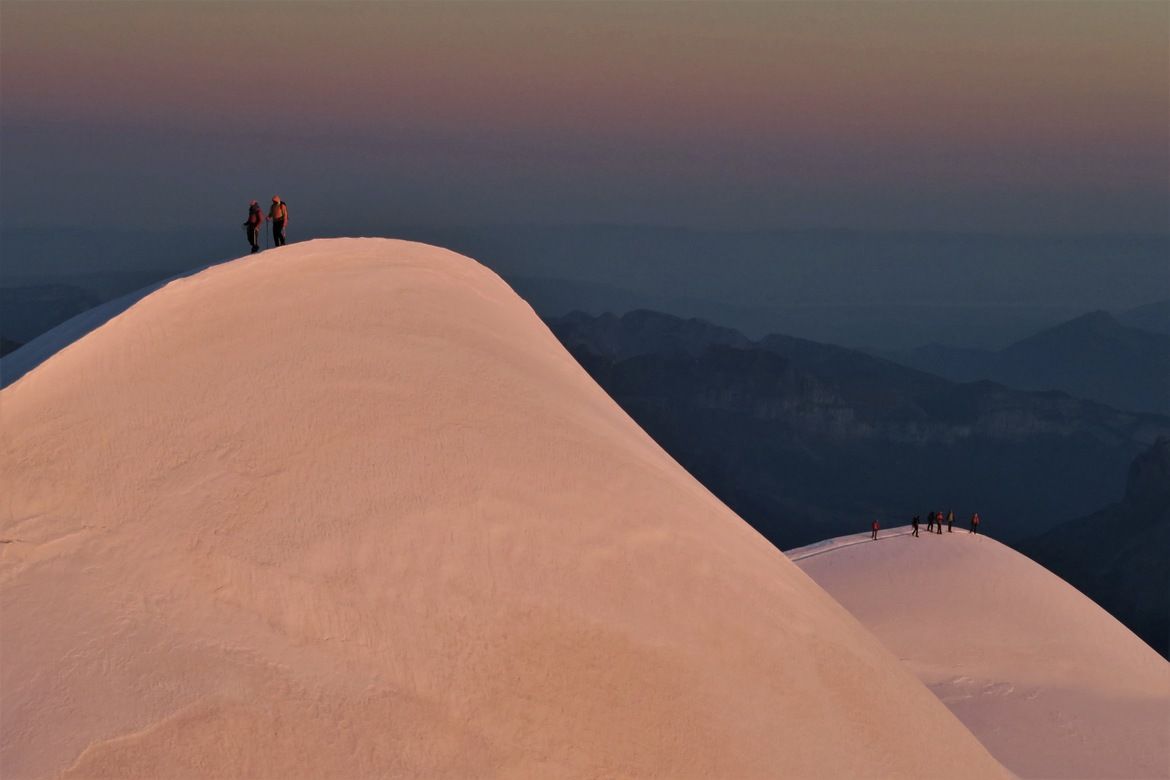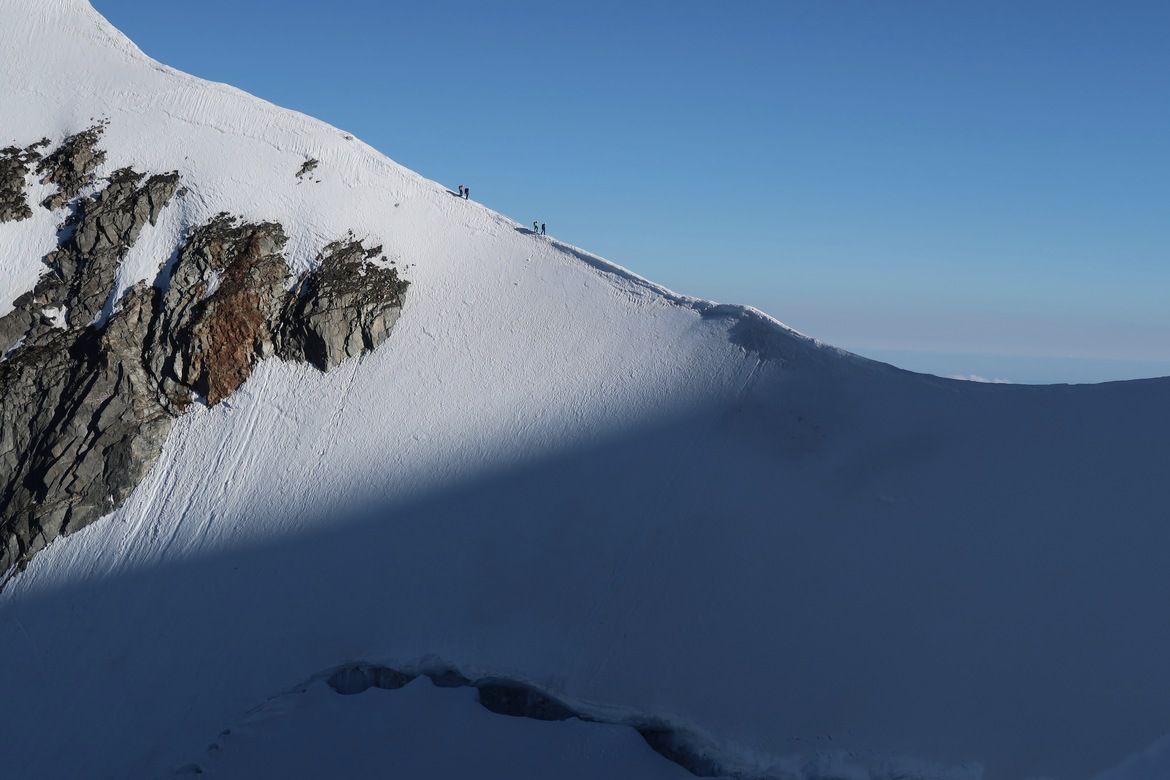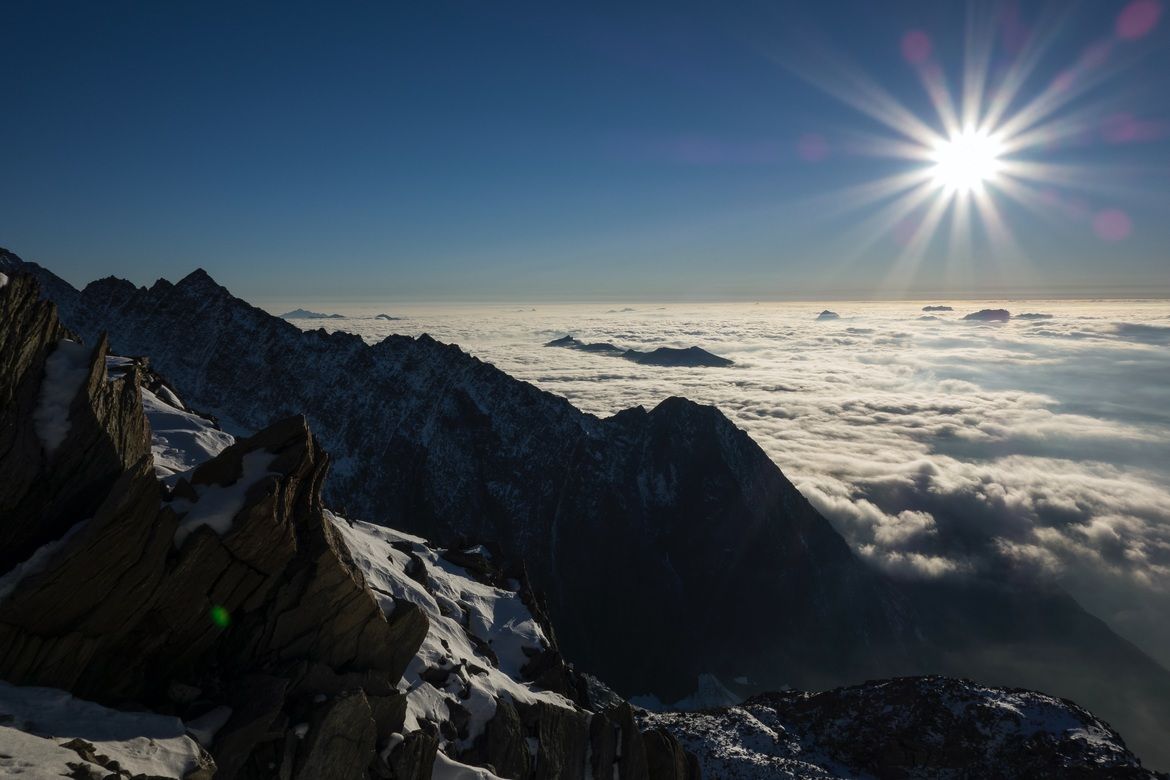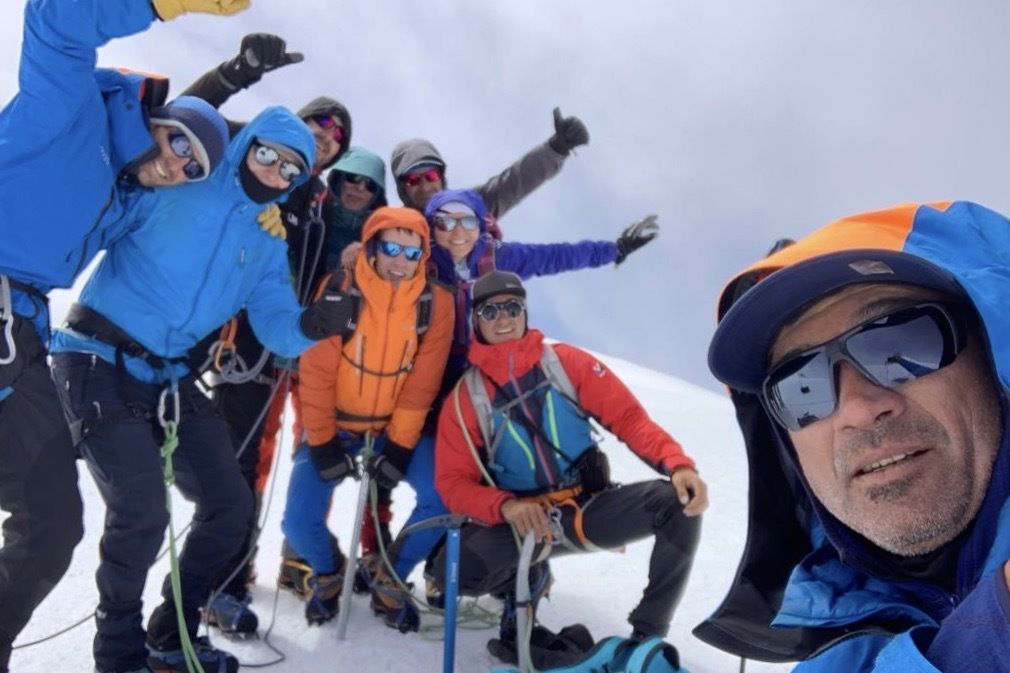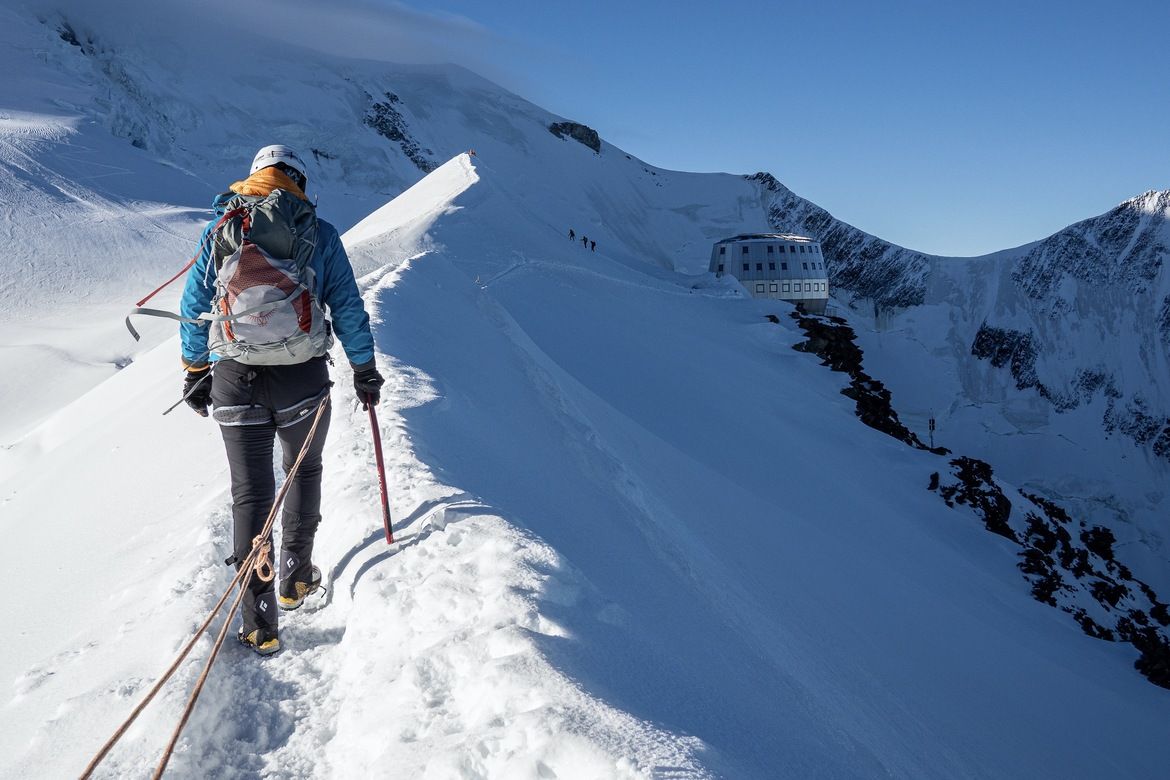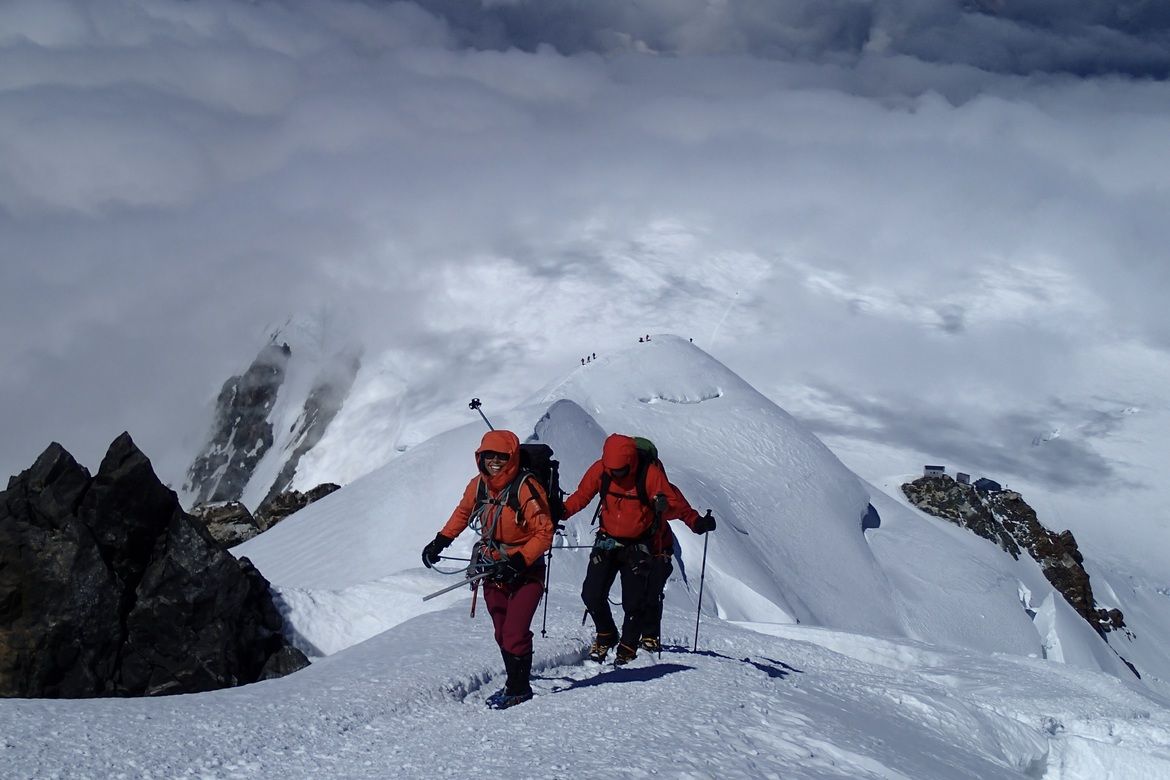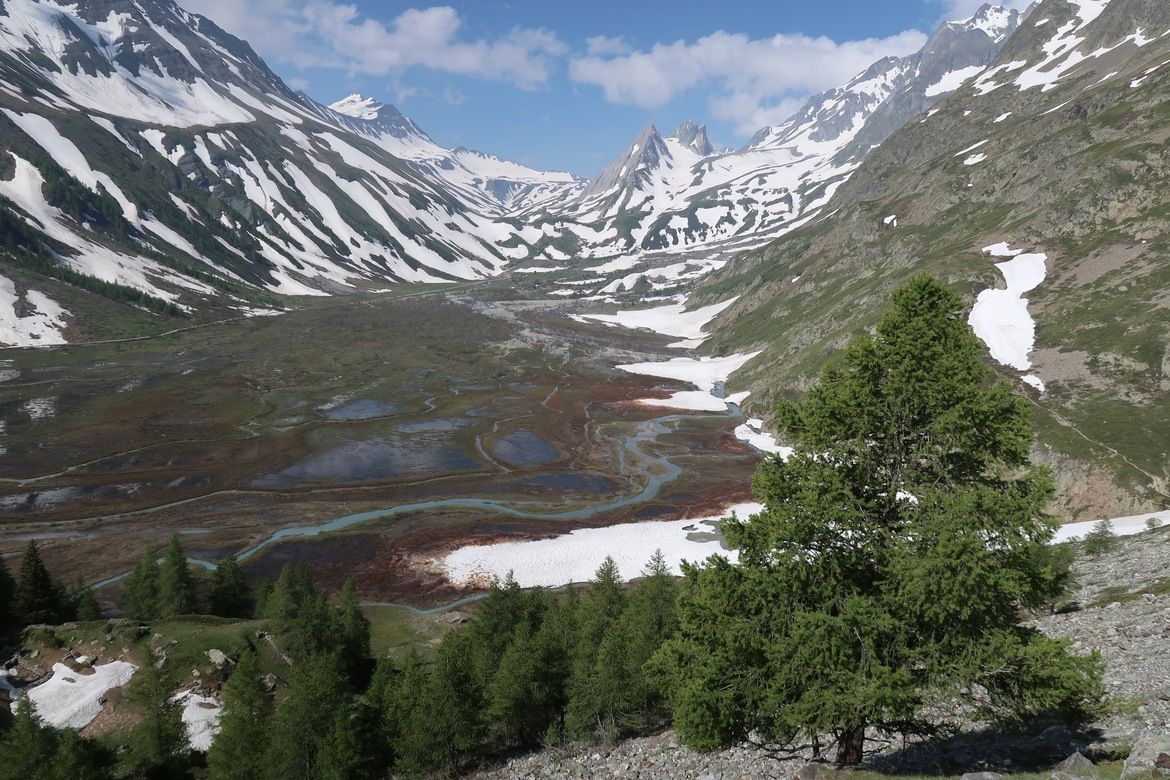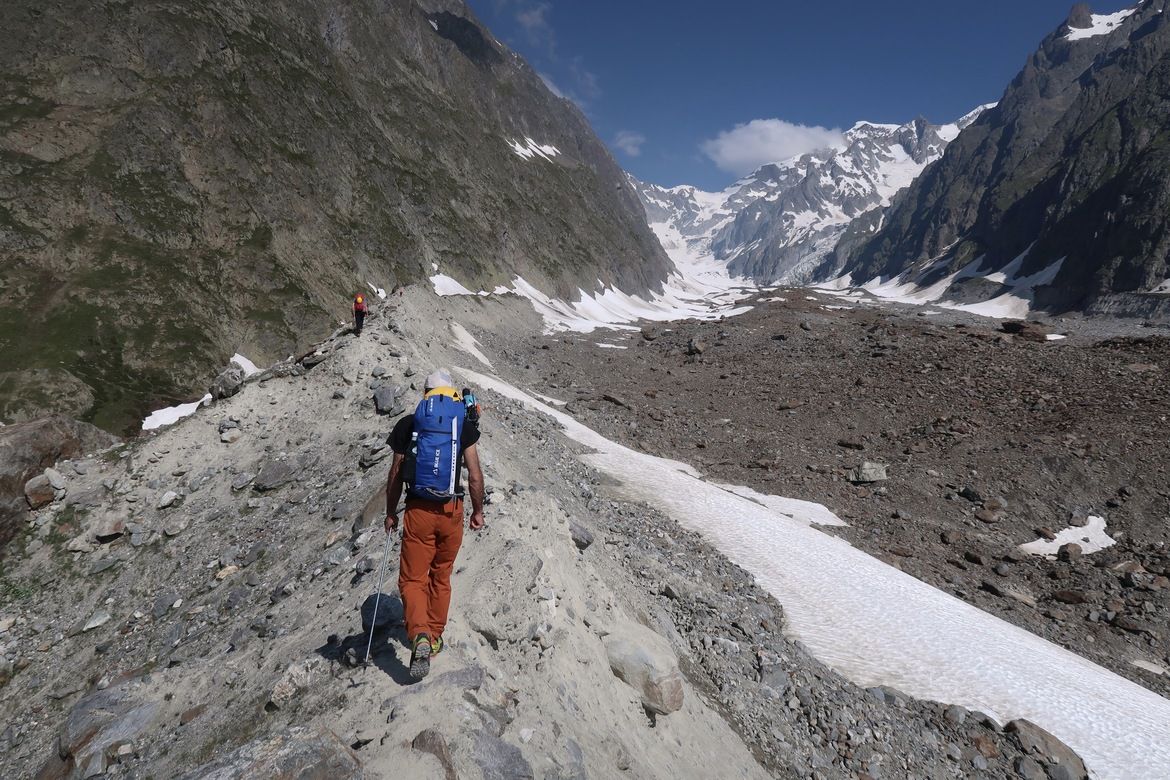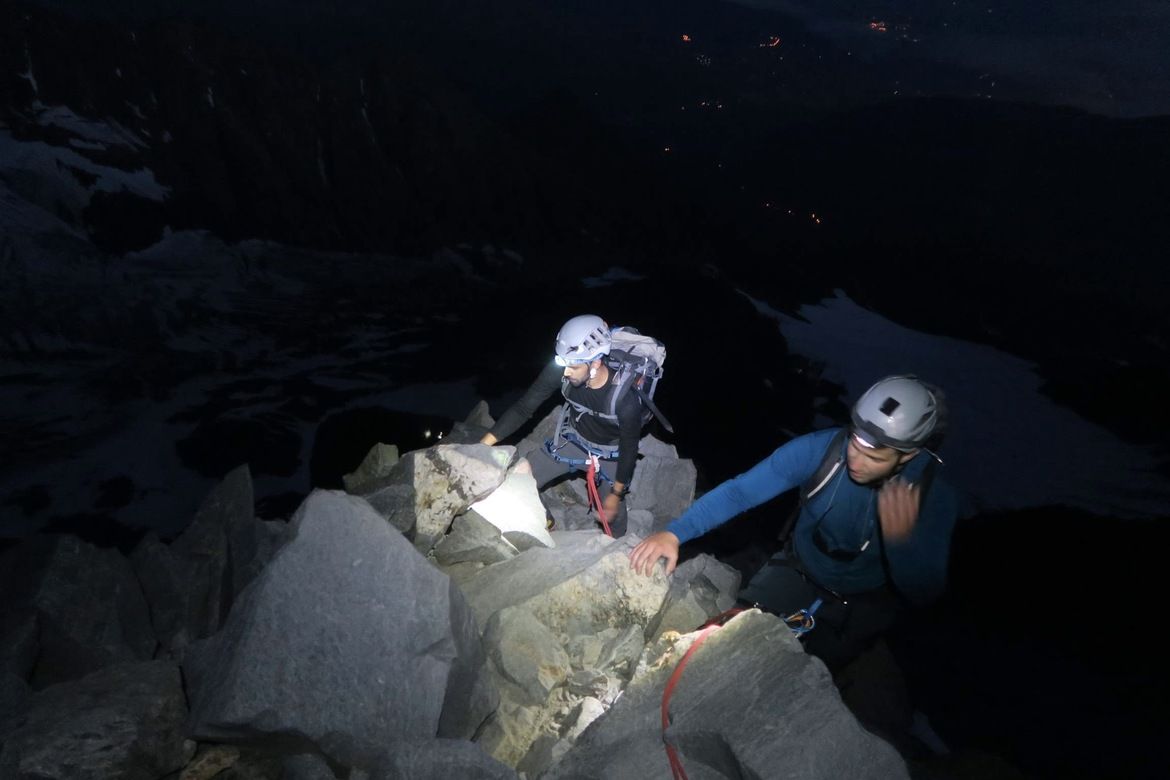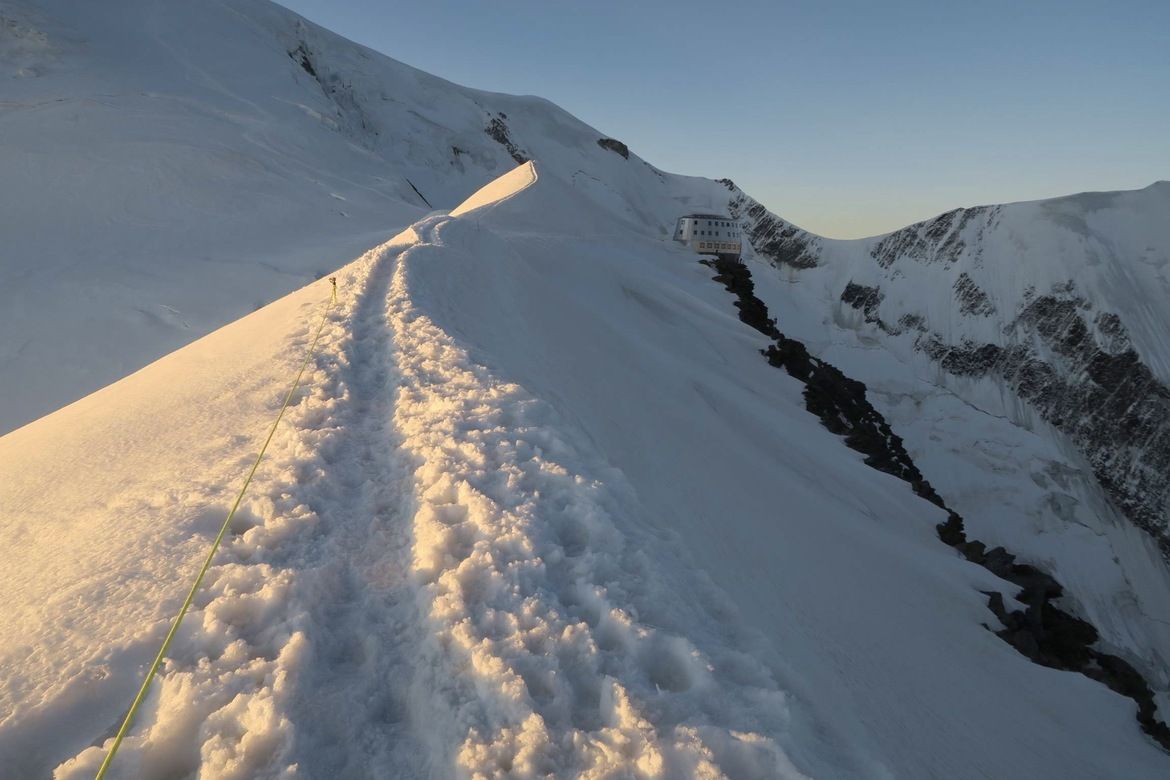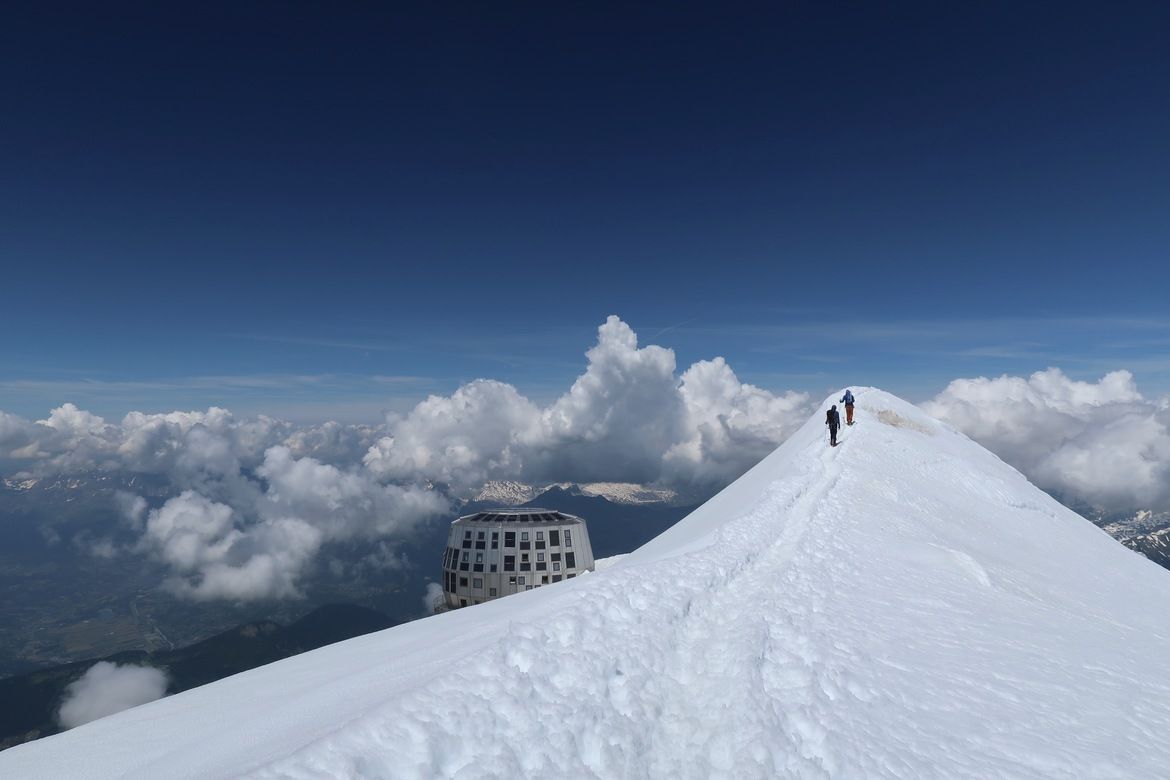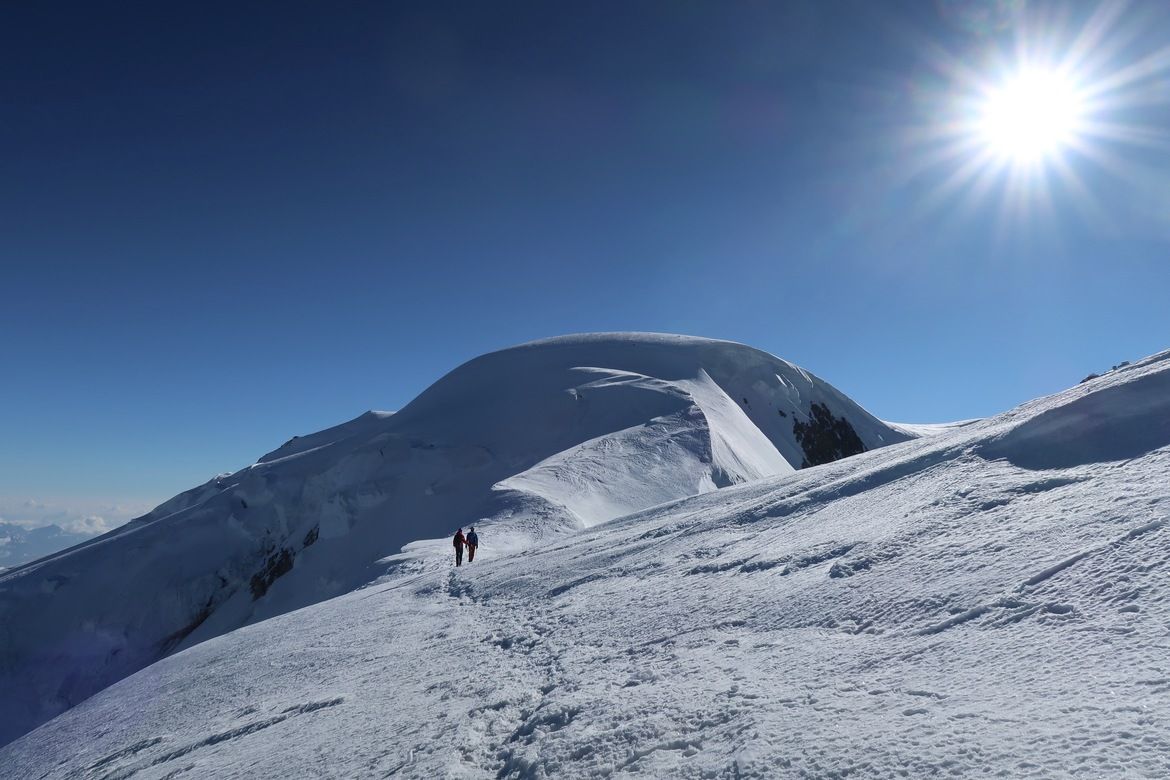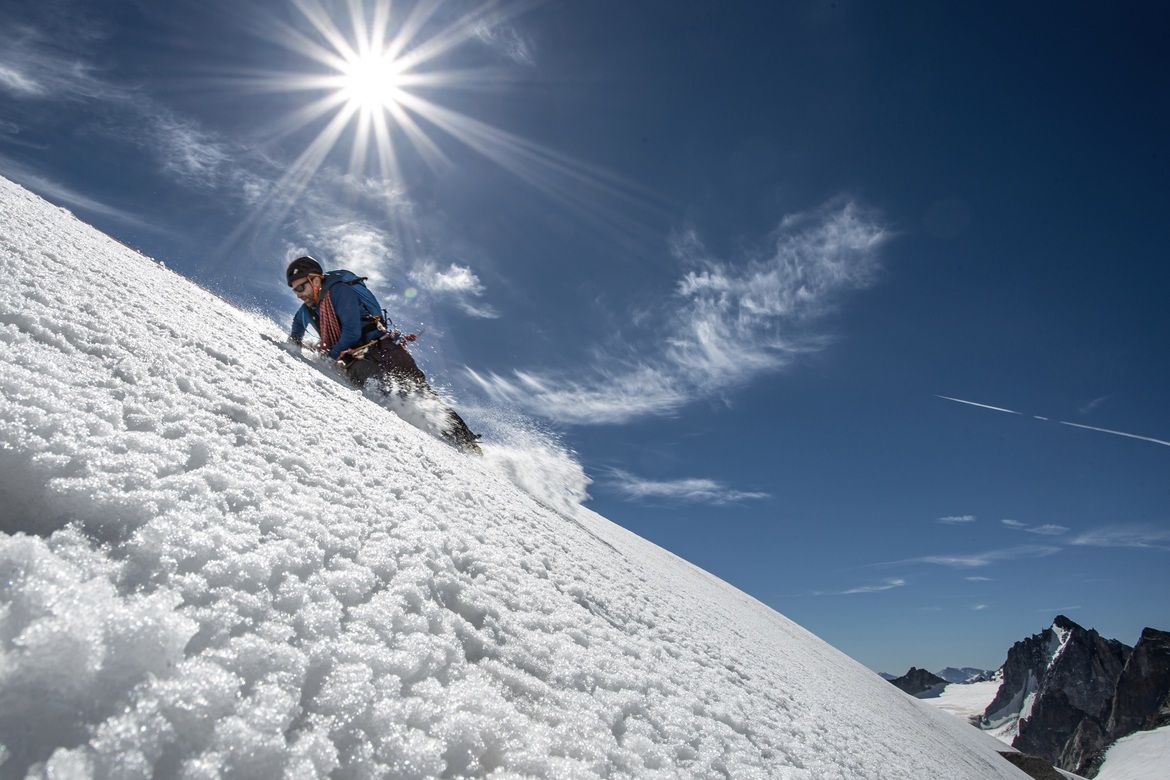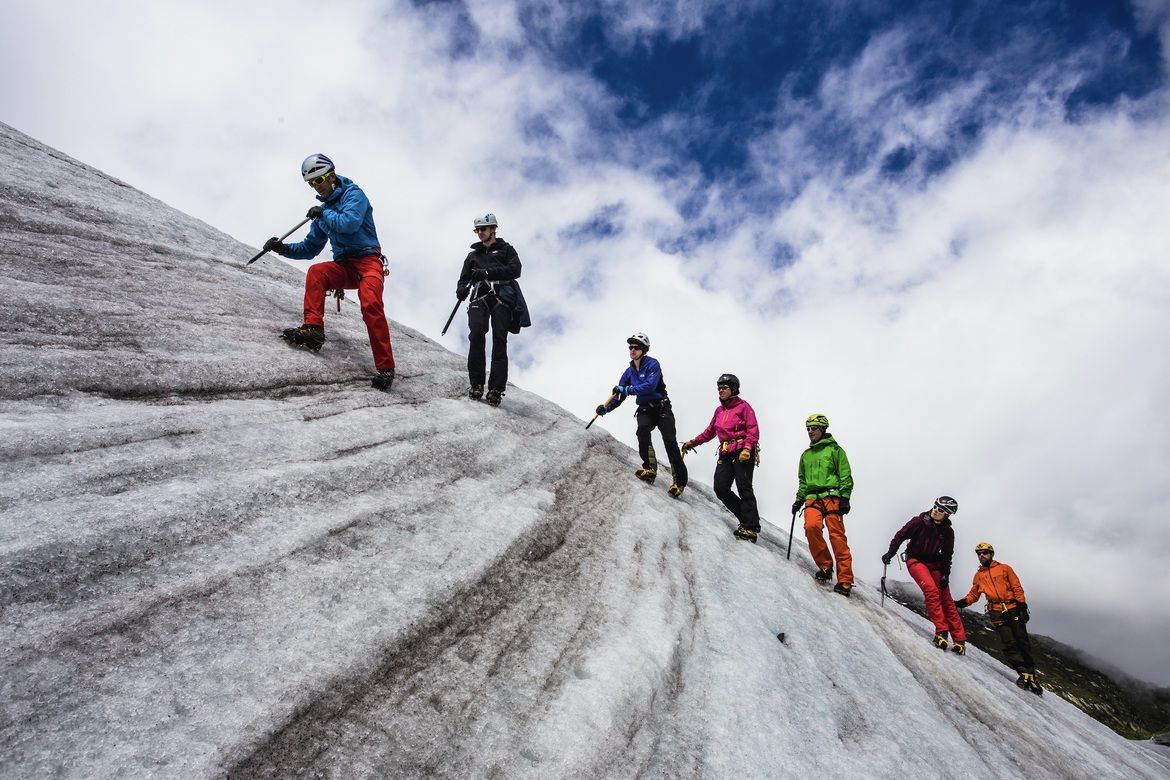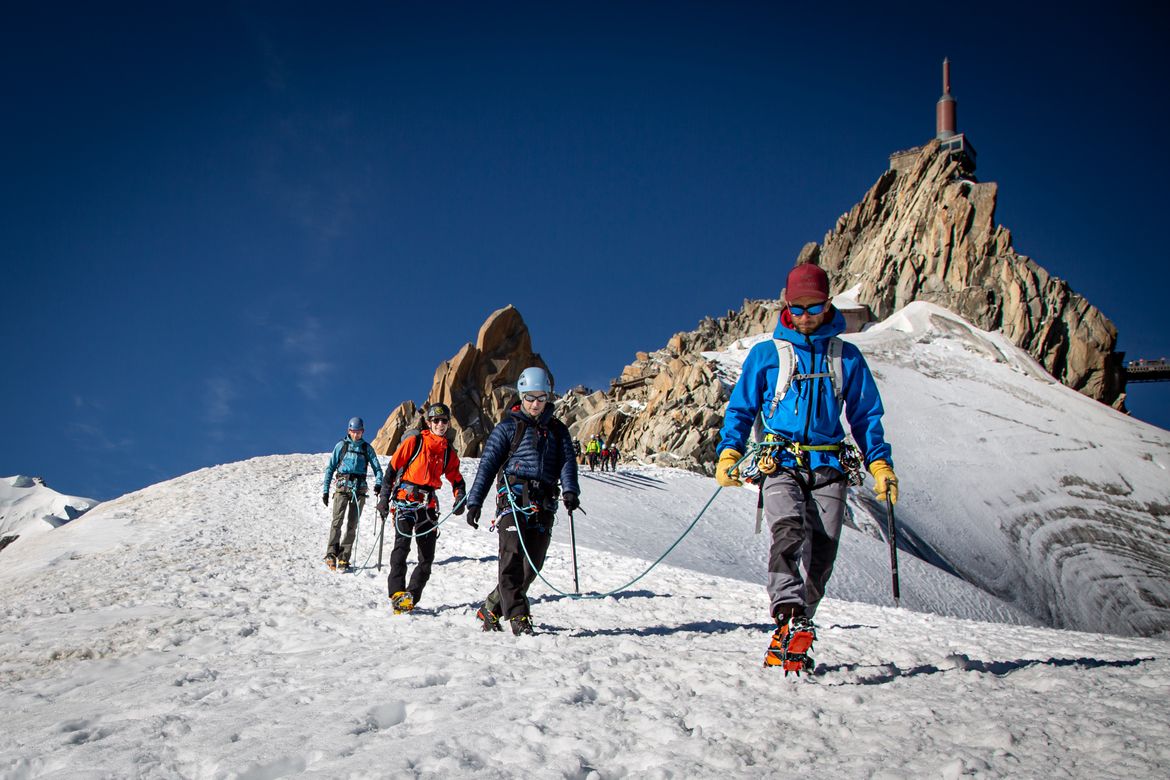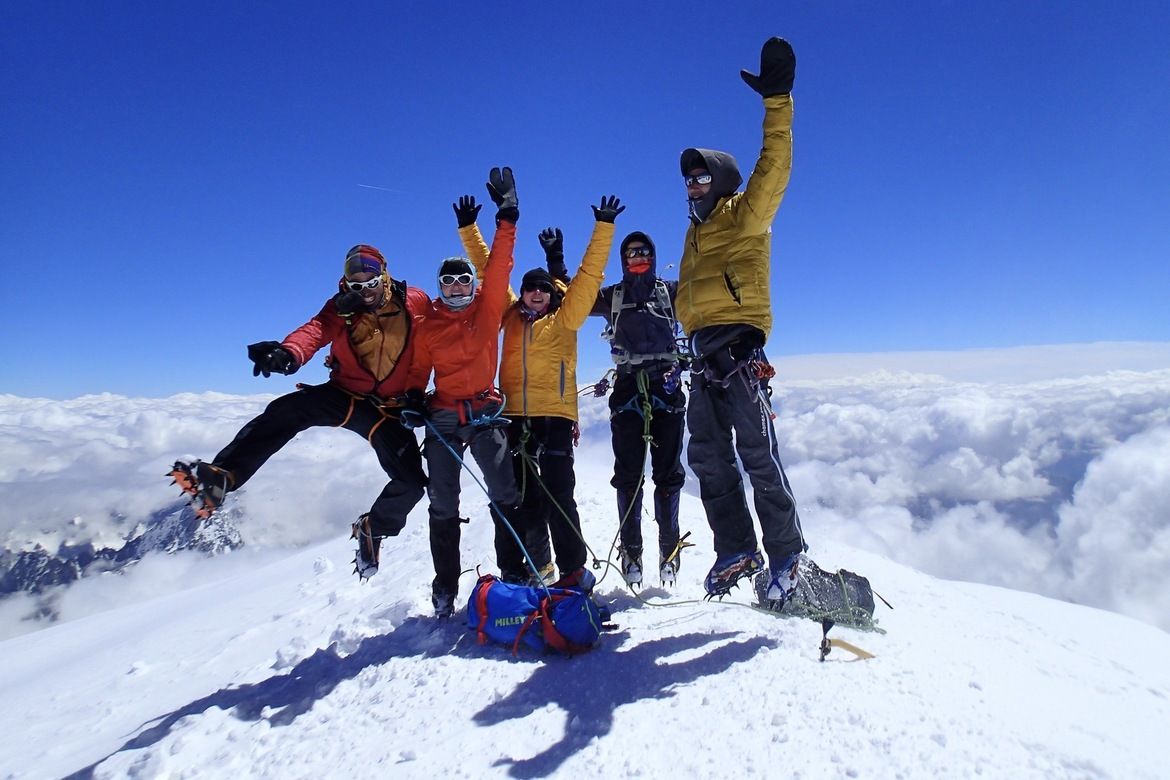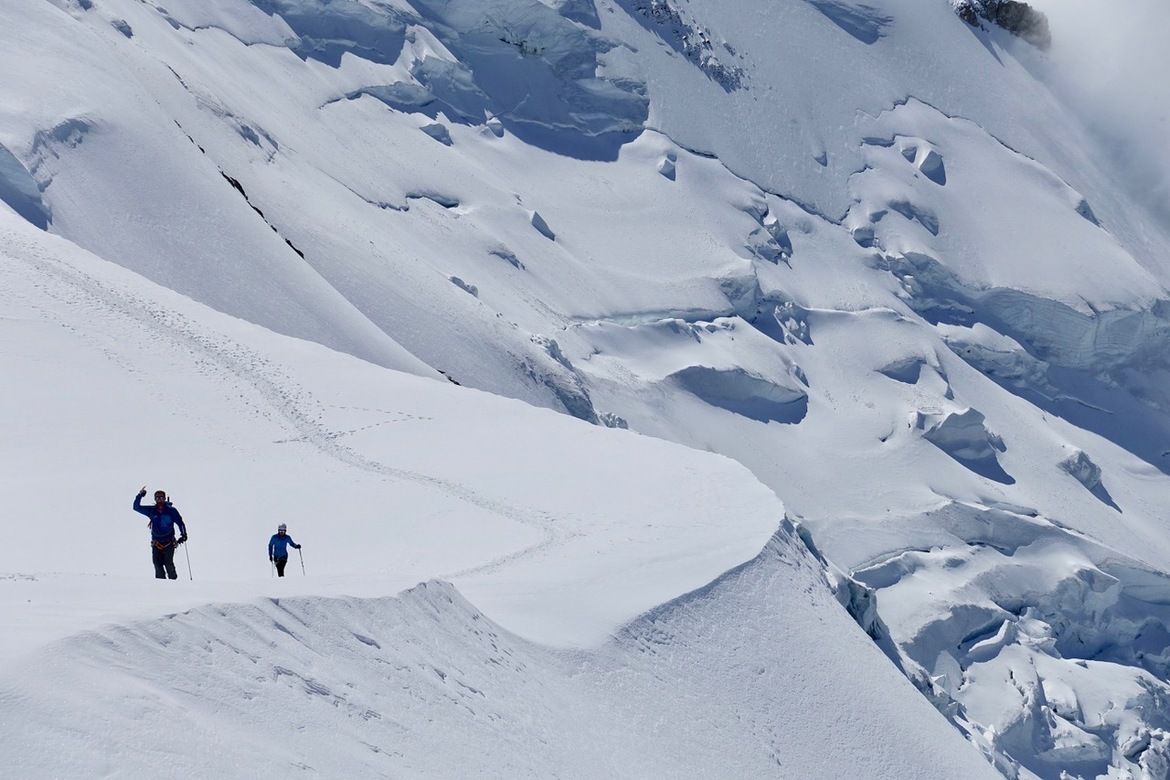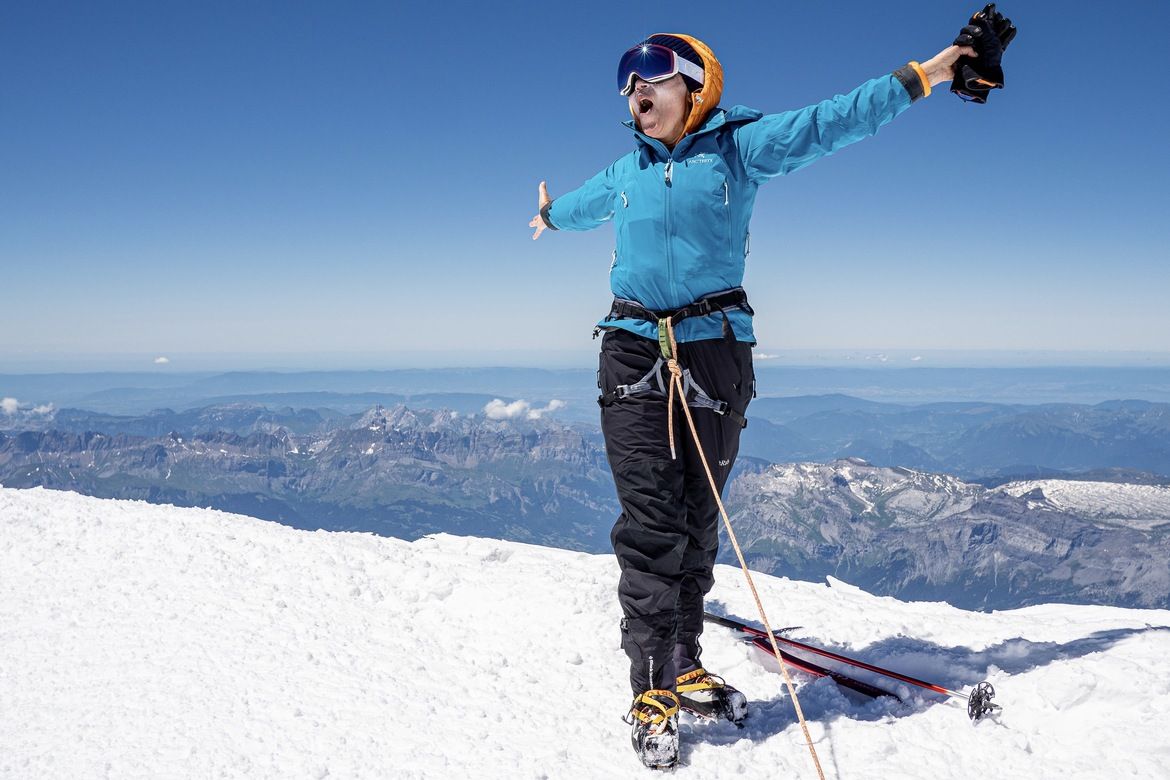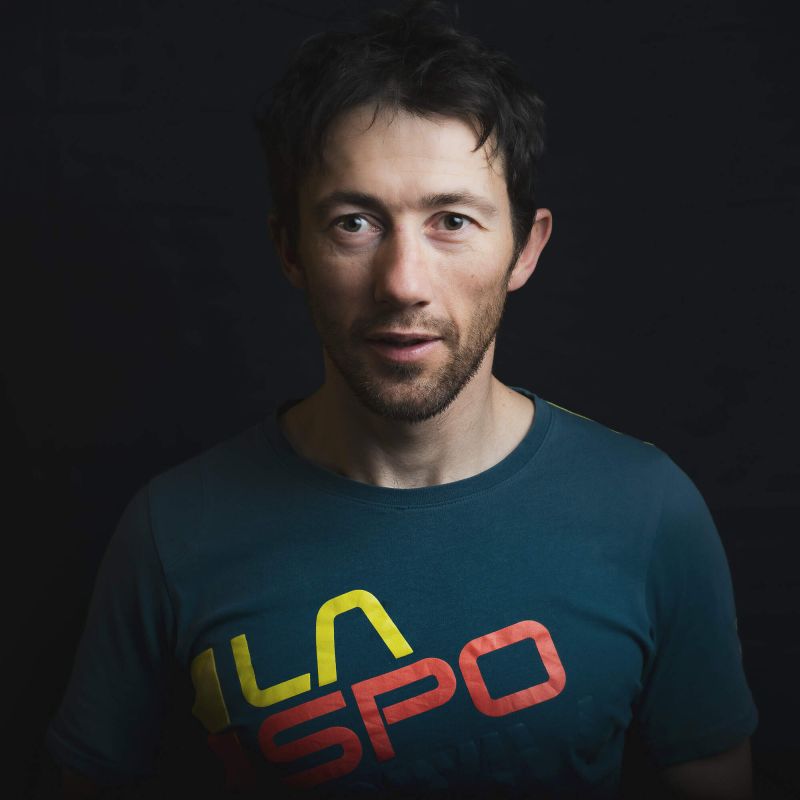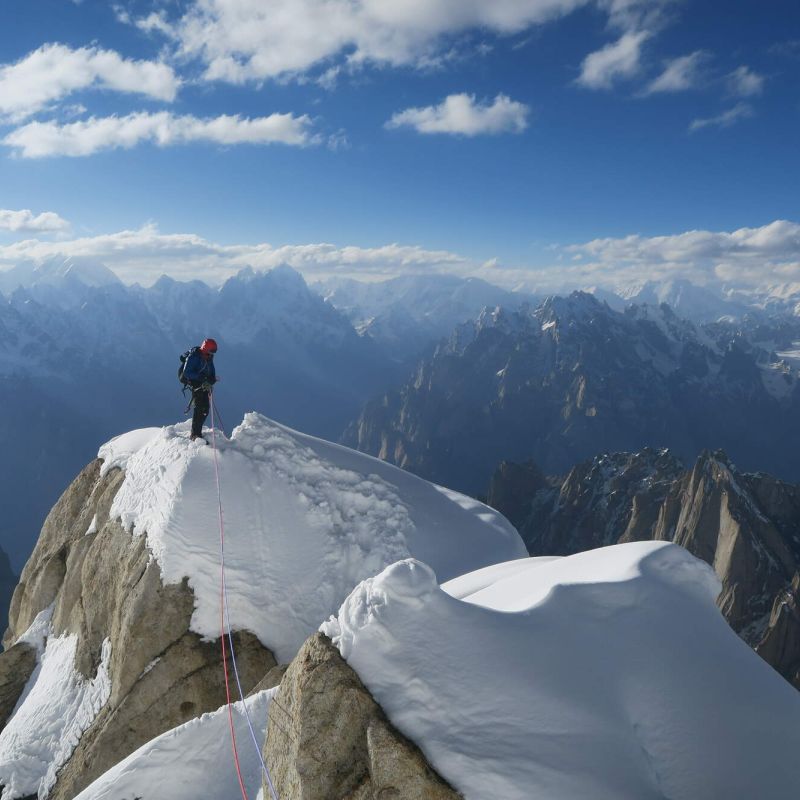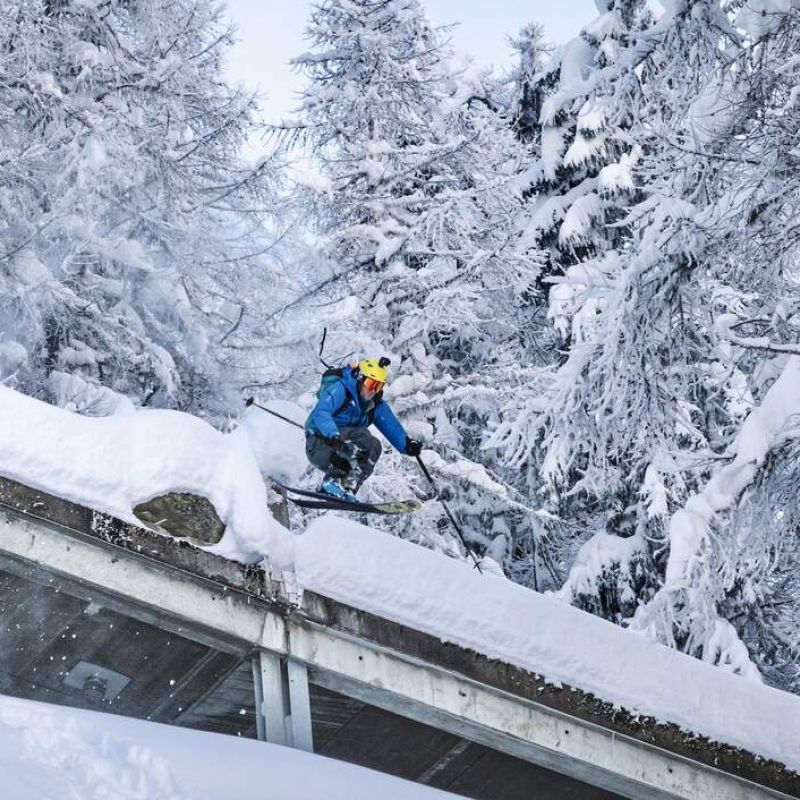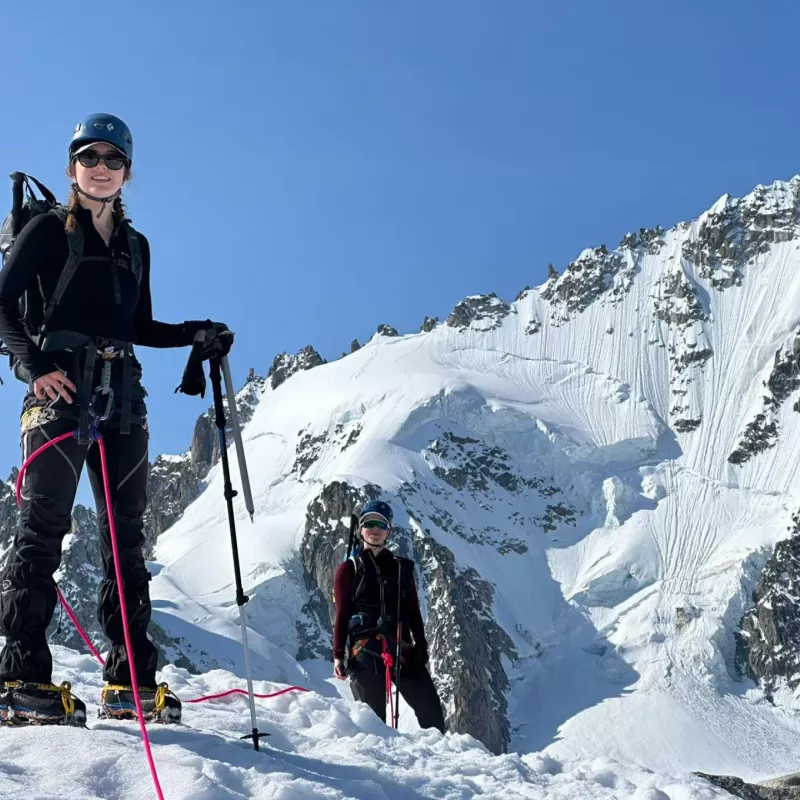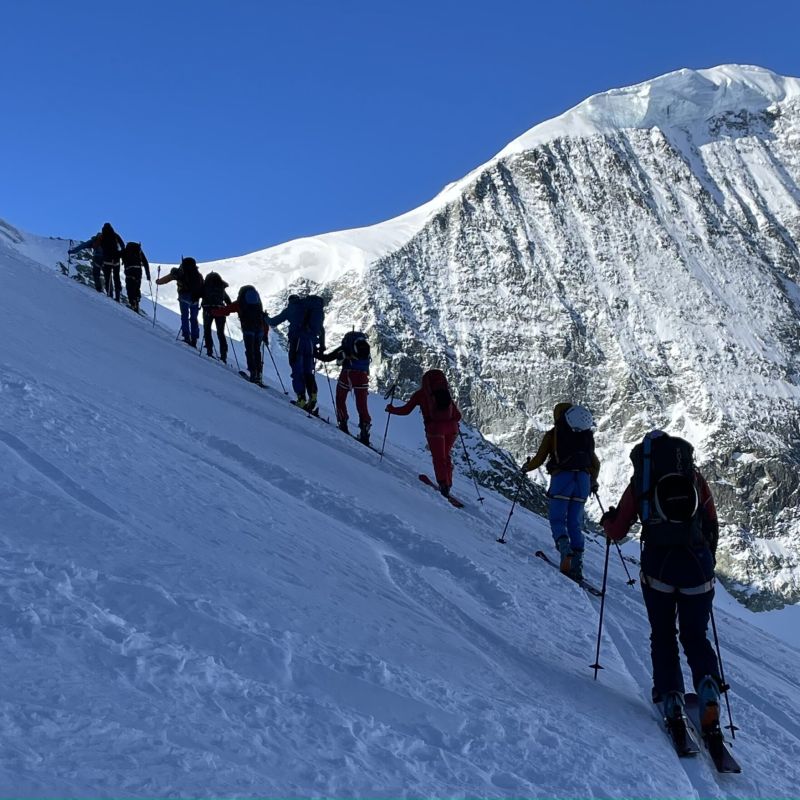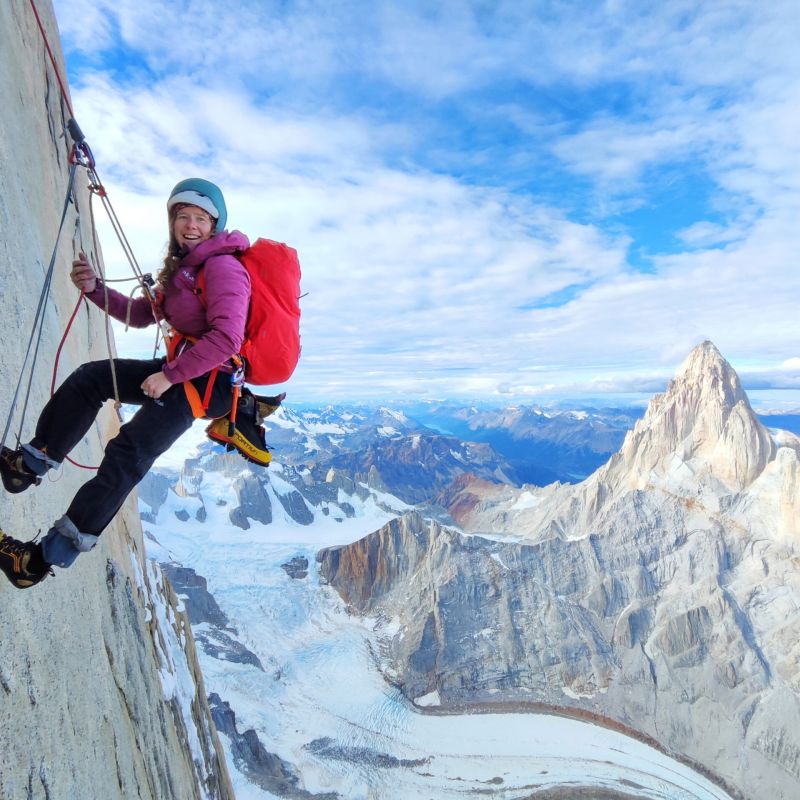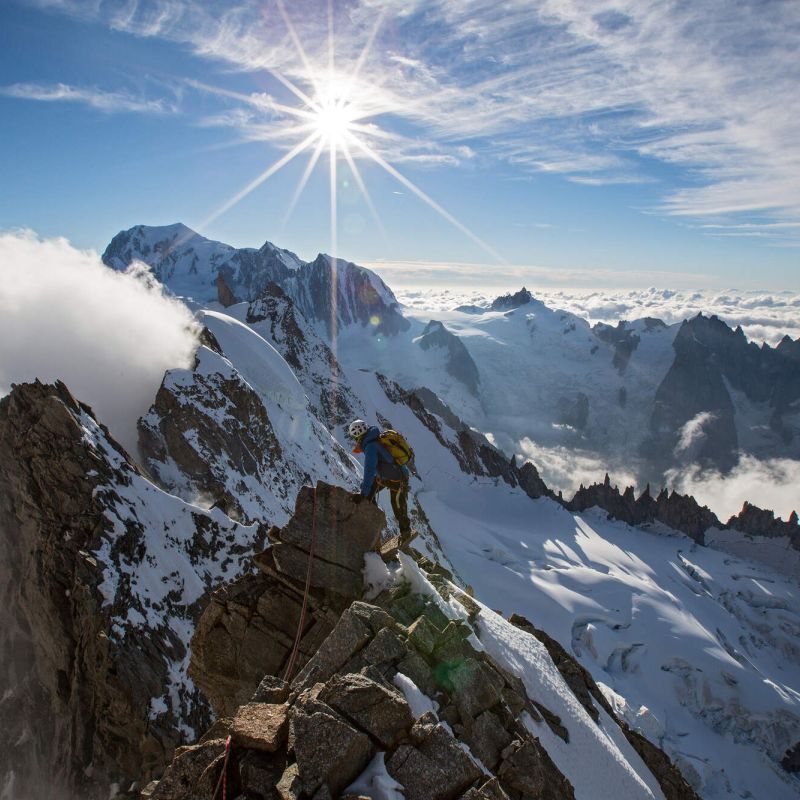Le manuel du Mont-Blanc
4810m. Le point culminant des Alpes occidentales, gravi pour la première fois en 1786, reste un défi au XXIe siècle. Le sommet attire des alpinistes de tous niveaux venus du monde entier. Ses différents aspects présentent des itinéraires qui datent de chaque époque, gravis par les grands alpinistes en leur temps. Chamonix est le berceau de l’alpinisme – le dôme blanc préside aux tours rocheuses escarpées, aux crevasses chaotiques, aux pâturages des hautes vallées, aux villes animées, aux habitants et aux visiteurs.
Comment la frénésie de l’ascension du Mont-Blanc a-t-elle commencé ?
La première ascension, en 1786, marque un tournant dans l’alpinisme et donne une nouvelle idée de ce qui est possible. Horace – Benedict de Saussure, scientifique genevois de premier plan, met à prix la première ascension, inspiré par sa passion pour la science. Après une tentative ratée et un bivouac ouvert sur le glacier, Jaques Balmat prouve, au moins à lui-même, que les démons résidant dans le glacier ne dévorent pas les aventuriers nocturnes. Fort de ce point de vue radical et attiré par la promesse d’une prime à la première ascension, il est prêt à aller plus loin que les précédents. Un jeune médecin de Chamonix, Michel-Gabriel Paccard, lui-même auteur de multiples tentatives, dont celle de Balmat, sera son compagnon. Chargés de matériel scientifique (Paccard souhaite relever un baromètre depuis le sommet) et utilisant des bâtons de bois en guise de piolets, ils parviennent à parcourir le glacier des Bossons depuis le sommet de la Jonction, le haut rocher où ils bivouaquent avant de partir. Un temps parfait, la pleine lune, l’ignorance, le courage et la chance leur ont permis d’atteindre le sommet (et les ont aidés à redescendre) le 8 août 1786. L’itinéraire des Grands Mulets, skié le plus souvent à la fin du printemps ou au début de l’été, est la variante moderne la plus proche de la première ligne d’ascension.
Une fois l’impossible réalisé, le Mont Blanc cède ses flancs à de multiples tentatives, essentiellement scientifiques. La première femme atteint le sommet en 1808 – Marie Paradis – accompagnée de Balmat et d’une équipe de guides. Servante à Chamonix, elle souffrait d’essoufflement, de fatigue extrême et de perte de la parole, symptômes courants de l’exposition à la haute altitude.
La Compagnie des Guides de Chamonix – la plus ancienne compagnie de guides au monde et toujours très active 200 ans plus tard – a été créée en 1821 (nous reviendrons plus tard sur cette étape importante de l’histoire du sommet). En 1887, Joseph Vallot passa trois jours et trois nuits au sommet pour prouver qu’il était possible de vivre en haute altitude. En 1890, il construisit un observatoire sur un affleurement rocheux situé sous le sommet. La même année, l’astronome Pierre Janssen construisit un observatoire au sommet, mais la calotte glaciaire du sommet l’engloutit rapidement. L’observatoire Vallot et le bivouac qui l’accompagne subsistent aujourd’hui. Le bivouac sert d’abri d’urgence aux alpinistes de la voie du Gouter, et l’observatoire est utilisé pour des recherches physiologiques en haute altitude.
Au fur et à mesure que la communauté des alpinistes s’élargit et que la technologie, les techniques et la curiosité progressent, de nouveaux itinéraires s’ouvrent sur tous les versants du Mont Blanc. La voie normale italienne, ou Aiguilles Grises, était descendue avant d’être gravie par la voie des Aiguilles Grises. Les deux guerres mondiales ont rapidement mis un terme à l’alpinisme touristique, mais les progrès technologiques et les expéditions parrainées par les autorités nationales, qui avaient les yeux rivés sur l’Himalaya, ont permis de former et de pousser les niveaux techniques plus loin, à la recherche de terrains toujours plus escarpés et plus éloignés. Chaque génération a repoussé, et continue de repousser, les limites de l’alpinisme dans la chaîne. La vitesse a récemment regagné en popularité, les athlètes mutants cherchant à améliorer leurs temps respectifs. Kilian Jornet détient actuellement le record de vitesse en moins de cinq heures (4h57min34sec) de l’église de Chamonix jusqu’au sommet et retour à l’église !
Les Guides
Le point de vue d’un guide sur le mont Blanc sera toujours très personnel, mais la prospérité apportée aux vallées de Chamonix et d’Aoste par la présence du mont Blanc est indéniable. Les guides de montagne ont d’abord été des porteurs et des propriétaires de mulets locaux qui franchissaient les cols de haute montagne. Il s’est rapidement développé à mesure que les voyageurs de l’époque victorienne recherchaient l’air frais des glaciers et que les bains thermaux adjacents – utilisés pour traiter le scorbut, l’épilepsie, les affections cutanées, les ulcères et d’autres maladies – gagnaient en popularité. L’augmentation du nombre de voyageurs entraîne une augmentation du nombre de décès, et une expédition malheureuse en 1820 coûte la vie à trois guides. En conséquence, la Compagnie des guides de Chamonix est créée en 1821 pour venir en aide aux familles des guides. Elle permet non seulement d’assurer la sécurité financière des familles de guides, mais aussi de répartir une charge de travail de plus en plus importante. Un âge d’or s’ouvre dans le massif, où chaque aventure vers un col ou un sommet de 4000 mètres est une première ascension. L’alpinisme en tant que loisir s’installe dans les Alpes et, à l’exception des périodes de guerre, ne les quittera jamais.
Un guide de montagne qui travaille régulièrement sur le Mont Blanc peut facilement faire plus de 100 sommets au cours de sa carrière, et parfois jusqu’à 10 à 15 fois au cours d’une saison d’été. Il fut un temps où les guides de Saint-Gervais logés en permanence au refuge du Gouter pouvaient faire le sommet tous les jours pendant de longues périodes de beau temps, accueillant de nouveaux clients chaque jour et faisant leurs adieux à ces mêmes clients l’après-midi suivant. Les informations sont rares, mais des rumeurs alimentées par le génépi font état d’anciens guides de St Gervais qui auraient fait plus de 500 sommets au cours de leur carrière !
La tradition du guidage s’étend directement à la pratique d’aujourd’hui. La plupart des groupes qui réussissent le Mont Blanc sont accompagnés par des guides. Les avantages d’une aide locale sont nombreux : connaissance intime des conditions, réservations complexes de refuges, aide pour l’équipement technique, développement des compétences nécessaires à l’escalade et rythme de progression. Les guides sont en majorité français, bien que de nombreux guides internationaux s’installent en permanence dans la vallée de Chamonix. Souvent motivés par leur passion pour la montagne, les guides peuvent remplir leur agenda avec suffisamment de travail pour pouvoir ensuite prendre le temps de faire du ski et de l’escalade. Avec une estimation de 20 000 ascensions par an pour le seul Mont Blanc, Chamonix a généralement plus de travail que de guides disponibles en haute saison.
Les variantes
La plupart des ascensions se feront par l’un des trois itinéraires. Toutes sont longues, techniques et exigent une bonne condition physique et de l’entraînement. Du côté français – soit l’itinéraire des trois Monts depuis l’Aiguille du Midi, soit l’itinéraire du Gouter depuis St Gervais ou Les Houches.
La progression se fait entièrement sur terrain glaciaire, en escaladant des parties importantes du Mont Blanc du Tacul (1 Mont) et du Mont Maudit (2 Monts), généralement sans atteindre le sommet de l’un ou l’autre. Exposé aux chutes de glace des glaciers en surplomb et presque entièrement situé au-dessus de 4000 m d’altitude, cet itinéraire reste populaire en raison de sa proximité avec l’Aiguille du Midi. Si le sommet du Mont Blanc semble proche à 4810m (3 Monts) du sommet de l’Aiguille à 3860m, c’est une illusion – un terrain complexe et dangereux sépare les deux points. La plupart des ascensions partent du refuge Cosmique, près de la base de l’Aiguille du Midi, à 2 heures du matin pour atteindre le sommet à une heure raisonnable.
L’itinéraire du Gouter est beaucoup plus fréquenté, et donc plus commercial. Bien qu’il ne soit pas aussi techniquement exigeant que les autres itinéraires menant au sommet, cet itinéraire ne doit pas être pris à la légère. L’accès en train au Nid d’aigle (2362m) et une randonnée d’approche permettent d’accéder au refuge de Tete Rousse (3167m). C’est généralement la première nuit d’un voyage mené par Chamex. Deux heures d’escalade technique depuis Tete Rousse permettent d’atteindre le refuge Gouter (3835m), récemment construit, pour une brève pause. La recherche d’itinéraire et les capacités d’escalade sont importantes pour monter et descendre la paroi rocheuse de l’Aiguille du Gouter, orientée à l’ouest. Le réchauffement climatique a radicalement modifié les conditions générales de l’itinéraire, le rendant impraticable pendant les périodes les plus chaudes de l’été. Les chutes de pierres dans le Grand Couloir exposé peuvent être la cause de nombreux accidents chaque saison. L’aller-retour entre les deux refuges est le point crucial de la technique.
Depuis le refuge du Gouter, l’ascension passe de l’escalade raide à la marche glaciaire à faible angle, à mesure que l’on se trouve face au Dôme du Gouter. Après environ deux heures, le bivouac de Vallot est atteint. Le terrain se raidit juste avant la cabane, et le reste de l’itinéraire nécessite un usage prudent des crampons et un jeu de jambes attentif. L’arête de la Bosse ressemble aux bosses d’un dos de chameau de Chamonix, mais la difficulté de chaque pas est amplifiée par l’altitude et la fatigue croissante. Encore une heure et la crête du sommet final est atteinte. Le terrain est de moins en moins escarpé – ce qui donne malheureusement l’illusion d’un sommet qui s’échappe – jusqu’à ce que le plateau final soit atteint. La descente vers le refuge Gouter retrace les étapes de l’ascension – beaucoup plus facile, mais nécessitant toujours une concentration sans faille – c’est exposé ! Au fur et à mesure de la descente, l’oxygène est plus facilement absorbé, et une bière de fête vous attend à la cabane.
L’itinéraire italien entre le glacier de Miage et le refuge Gonella (3071 m) est la troisième option, la moins populaire, bien qu’elle puisse être une alternative intéressante à l’itinéraire français, plus commercial. Plus longue et plus dépendante des bonnes conditions glaciaires, elle requiert des alpinistes en bonne forme et plus expérimentés. Une longue marche dans le Val Veny mène au refuge, et les 1400 mètres d’altitude gagnés lors de l’approche le premier jour ne représentent qu’un tiers de l’effort nécessaire pour atteindre le sommet via les 1700 mètres d’ascension au-delà des Aiguilles Grises jusqu’au sommet. Le glacier du Dôme est vaste, complexe et sauvage. Les tentatives en fin de saison peuvent être contrariées par un labyrinthe impénétrable de crevasses, révélées lorsque la neige de l’hiver a disparu. La voie italienne rejoint la voie du Gouter au Dôme de Gouter, et les dernières heures jusqu’au sommet sont partagées le long de la crête nord-ouest du Mont Blanc.
Parmi les autres variantes populaires, on peut citer la traversée royale – qui s’attaque aux dômes de Miage et à l’aiguille de Bionnassay avant d’arriver au sommet du dôme de Gouter – et l’itinéraire des Grands Mulets. La première offre une spectaculaire traversée de l’arête de neige à 4000 m, et la seconde est la variante de ski de randonnée la plus populaire, et ressemble le plus à l’itinéraire emprunté par Balmat et Paccard lors de la première ascension. Ces deux itinéraires requièrent une expérience alpine dans chaque domaine. L’ascension du Mont Blanc est une randonnée à ski longue et technique qui, bien qu’elle ne dure généralement que deux jours, nécessite une bonne acclimatation pour être appréciée au mieux. La traversée royale est une mission pour les alpinistes entraînés qui ont une bonne endurance.
Chaque itinéraire sommital apporte sa propre satisfaction, et chaque sommet – même réalisé plusieurs fois par le même itinéraire – est unique et gratifiant. Bien qu’il ne s’agisse plus de l’aventure pionnière dans laquelle Balmat et Paccard se sont lancés il y a près de 250 ans, la vue depuis le sommet est sans aucun doute similaire à ce qu’ils ont dû voir, et l’exaltation d’arriver au sommet de l’Europe occidentale est une émotion partagée par les alpinistes du monde entier.
Preparation
Les séjours Mont-Blanc modernes sont plus axés sur la préparation – les clients passent trois ou quatre jours à se préparer et deux ou trois jours sur le Mont-Blanc. Cette méthode offre les meilleures chances de réussite, car chaque client qui tente l’ascension possède les compétences rudimentaires nécessaires pour atteindre le sommet. Dans le cas d’une poussée de trois jours, il y a également une certaine flexibilité avec les jours de sommet en cas de mauvais temps. La nature fait la loi dans l’alpinisme de haute altitude, et même une brève tempête ou un vent violent peuvent rendre le sommet inaccessible.
En général, les clients qui ne parviennent pas au sommet sont arrivés extrêmement mal préparés. Dans des cas extrêmes, la question a été posée de savoir s’il fallait des crampons pour atteindre le sommet ! Bien que les guides et l’équipe du bureau fassent de leur mieux pour aider les clients à atteindre leurs objectifs, une participation active est nécessaire. Chamex s’efforce d’éloigner les alpinistes débutants du Mt. Blanc et recommande vivement, au minimum, une semaine d’initiation à l’alpinisme. Ce cours est l’introduction idéale aux nombreuses compétences qui rendront l’alpiniste débutant plus efficace et mieux préparé pour les ascensions alpines. Un minimum de familiarité avec le terrain, le matériel et les techniques alpines permet une ascension sûre et agréable. Chamex propose un complément de trois jours pour les sommets à notre cours Alpi 1.
Gaston Rébuffat, célèbre alpiniste et écrivain français, a dressé la liste des 100 plus belles voies du massif du Mont-Blanc par ordre de difficulté, depuis les ascensions les plus faciles et les journées d’entraînement jusqu’aux voies les plus dures du massif. Le Mont Blanc, par la voie du Gouter, se classe au 24e rang. Selon Rébuffat, un alpiniste doit avoir passé au moins trois à quatre semaines à faire de l’alpinisme et à acquérir de l’expérience avant de s’attaquer à cette voie, si l’on veut procéder de manière progressive. S’il est certainement possible pour certains de passer de zéro au sommet en l’espace d’une semaine, cela reste une exception et n’est pas recommandé.
Tous les grimpeurs n’ont pas le temps, l’accès ou le budget pour s’entraîner dans les Alpes. Pour ceux qui ne peuvent pas être là, voici quelques conseils (également valables pour ceux qui suivent un cours d’initiation à l’alpinisme !)
- Ne sous-estimez pas la difficulté du Mont Blanc. Ce n’est pas parce que votre voisin l’a fait et vous a dit que c’était facile que vous réussirez. De plus, la mémoire peut être extrêmement sélective, surtout en alpinisme.
- Faites de la condition physique une priorité. Plusieurs jours successifs de longues marches, de course à pied, de vélo, d’escaliers, d’évitement de l’ascenseur, etc. sont autant de méthodes valables pour améliorer sa condition physique générale. La plupart des entraînements doivent mettre l’accent sur l’endurance à long terme, car une journée alpine typique peut durer de 6 à 10 heures. Vous pouvez également trouver ce qui vous convient le mieux en matière de nutrition et d’hydratation. Vous devez arriver en forme. Vous pouvez vous acclimater et apprendre au cours d’une préparation de trois jours, mais votre condition physique ne s’améliorera pas. Les clients qui ne sont pas en forme feront d’autres activités – pas le Mont Blanc. Cette règle est pour le bien-être de tous, et bien que personne n’aime se faire dire qu’il ne peut pas y aller, il vaut mieux parfois, -le grimpeur têtu et inapte n’a aucune idée de ce qu’il demande à son guide d’accepter.ll, mais il est également possible de gagner des grammes (ce qui allège aussi souvent le portefeuille) en faisant des choix judicieux. Chamex peut vous conseiller et vous trouverez une page consacrée à l’équipement sur son site web.
- Faites de l’escalade. Une bonne connaissance des techniques de base de l’escalade (et un peu de forme physique !) vous permettra de gravir tous les sommets de 4000 m des Alpes. Il n’est pas nécessaire d’être un grand grimpeur – il suffit de faire ce que l’on peut, de s’amuser, et le terrain alpin en général sera facile. Une mauvaise perception et un refus de faire confiance à vos pieds peuvent ralentir votre mouvement jusqu’à l’arrêt, ou nécessiter plus d’efforts en raison d’une mauvaise efficacité. Un grimpeur solide est également plus sûr.
- Le matériel. Les chaussures sont l’élément le plus important. Bien que de nombreux magasins louent des chaussures d’alpinisme, il est préférable d’avoir une bonne paire de chaussures personnelles, adaptées à la forme de votre pied. Les chaussures doivent être compatibles avec les crampons et suffisamment chaudes pour résister au froid de l’altitude. Le choix des chaussures est personnel, et la forme du pied l’emporte sur tous les autres attributs. Si vous avez froid aux orteils, n’essayez pas de porter des chaussures légères. Compeed ou l’équivalent (ainsi qu’une trousse de secours personnelle de base) est essentiel – prenez soin de vos pieds car il est regrettable d’annuler des projets à cause d’ampoules douloureuses et infectées. Des bouchons d’oreille pour les dortoirs bruyants peuvent être très utiles. Pour le reste de l’équipement, la légèreté est de mise et la chaleur est une priorité. Il est important de porter des vêtements techniques, fonctionnels et de bonne qualité. Un sac à dos léger de 30 à 40 litres. Des crampons en acier à 12 pointes, un piolet classique, des bâtons de marche, un harnais, un casque peuvent également être loués, mais il est également possible de gagner des grammes (ce qui allège souvent le porte-monnaie) en faisant des choix judicieux. Chamex peut donner des conseils et le site web comporte une page consacrée à l’équipement.
- Utilisez votre passion pour vous inciter à faire vos devoirs. L’entraînement physique et l’équipement sont importants, mais il est tout aussi important de savoir exactement dans quoi vous vous engagez. Une préparation minutieuse est essentielle – chaque étape de votre voyage doit être étudiée. Connaître l’itinéraire du stage, lire les blogs d’autres personnes ou leurs aventures sur YouTube peut vous donner une idée de ce à quoi vous pouvez vous attendre et de ce qui vous attend.
Pourquoi escalader le Mont Blanc ?
Si le confort des refuges, l’accès généralement facile, une préparation assidue et 250 ans de progrès en matière de matériel, de textiles et de navigation augmentent les chances de réussite, nombreux sont ceux qui sont contraints de rebrousser chemin pour de multiples raisons. Si le sommet reste insaisissable pour l’alpiniste du XXIe siècle, c’est aussi une émotion partagée par d’innombrables tentatives ratées depuis près de trois siècles. Les conditions météorologiques, les problèmes de pied et le manque de condition physique sont les raisons les plus courantes pour lesquelles la semaine d’escalade peut se terminer sans avoir atteint le sommet. Mais l’expérience acquise est un bien précieux irrévocable pour l’avenir (même si l’on ne grimpe plus jamais !).
Le plaisir réside dans la préparation et le défi – la richesse du voyage ne doit jamais être éclipsée par le but ultime. La nature ne crée pas et ne mesure pas les sommets – et s’astreindre aux normes imposées par les hommes est rarement aussi gratifiant que ce que l’on aurait pu imaginer au départ. Le Mont Blanc était présent avant et sera toujours là bien après que la brève histoire de l’homme ait été effacée. Chaque alpiniste a ses propres motivations, uniques et valables, pour relever un défi. Il est peut-être préférable d’en discuter autour d’un bon vin, dans une cabane tranquille, après un bon dîner…
Les étoiles dans l’obscurité du petit matin, la Voie lactée dans toute sa splendeur, préservée des lumières de la ville. Le lever du soleil sur le sommet, et sa longue ombre qui s’étend sur la vallée en contrebas. La crête du sommet final, l’une des plus esthétiques des Alpes. Les vues sur les futurs objectifs potentiels – le Cervin, le Mont Rose, l’Aiguille Verte et les Grandes Jorasses – semblent toutes courtes depuis le sommet enneigé. Les conditions permettent de pique-niquer et de se reposer au soleil – profiter du moment, des accolades de félicitations et des photos….. La camaraderie s’est développée au cours de la semaine – une célébration de la fraternité gagnée en souffrant, en atteignant des sommets, en riant, en mangeant, en apprenant, ensemble. A bientôt là-haut !
